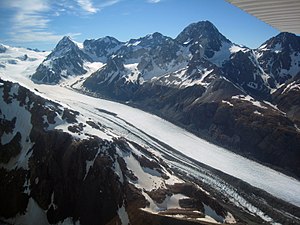New Zealand's Tasman Glacier has lost a 30 million tonne section of ice...
| Image via Wikipedia |
| Image via Wikipedia |
| Image via Wikipedia |

DENIS CALLESEN/Supplied
IN PERSPECTIVE: Tourists get an up-close look at a 40-metre-high iceberg
which calved from the Tasman Glacier.
Denis Callesen, general manager tourism for Aoraki Mount Cook Alpine Village, said the event about daybreak yesterday would have been "absolutely magnificent".
"A huge chunk of ice has literally broken away from the terminal face, and then fractured into dozens of icebergs. This is the first time that a calving has occurred across the whole 650-metre wide terminal face."
Photographers had several hours to capture images of the crystal-clear so-called blue ice on the base of an iceberg, which had been hidden beneath the surface for more than 300 years.
While the blue ice oxidized on exposure to air and turned white, it was expected visitors would be able to see some for several months, with one or two of the dozens of new icebergs rolling over every day. They did that as they maintained their equilibrium of 10 per cent above and 90 per cent below the water surface.
The section of ice that calved into the terminal lake was about 40 metres high above the water and went down below the surface by between 230 and 250 metres. An underwater tongue that was up to 120m high above the bottom of the glacier, and up to 400 metres out from the face also broke away.
Callesen said the 30 million tonnes of ice that moved was similar to the amount that moved in a calving triggered by last February's Christchurch earthquake.
The latest calving was "much prettier". It had left two large icebergs on the lake, one measuring about 150 metres by 75 metres, and the other about 100 metres by 50 metres. Both were about 40 metres above the lake surface at their highest point.
The glacier had been retreating by 100 to 300 metres each year, with about 120 metres lost yesterday.
- Acknowledgements: © Fairfax NZ News






0 Comments:
Post a Comment
Subscribe to Post Comments [Atom]
<< Home